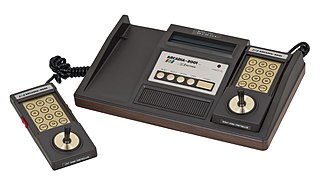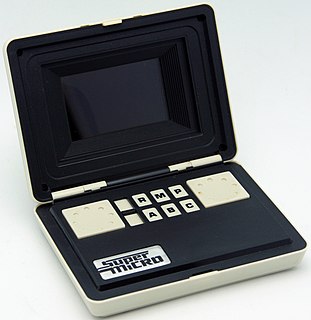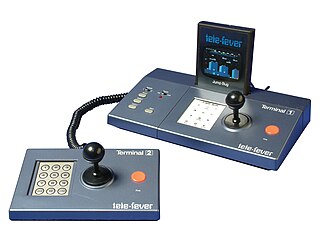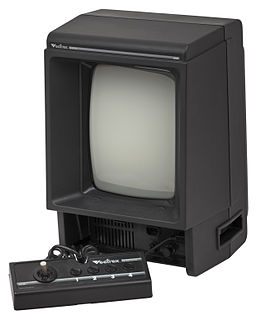 W
WThe 1292 Advanced Programmable Video System is a second-generation home video game console released by European company Audiosonic in 1978. It is part of a group of software-compatible consoles which include the Interton VC 4000 and the Voltmace Database. The 1292 Advanced Programmable Video System included its power pack inside the console instead of an exterior power pack.
 W
WThe APF Imagination Machine is a combination home video game console and home computer system released by APF Electronics Inc. in late 1979. It has two separate components, the APF-M1000 game system, and an add-on docking bay with full sized typewriter keyboard and tape drive. The APF-M1000 was built specifically to compete with the Atari 2600. The full APF Imagination Machine, including the APF-M1000 console and the IM-1 computer component, originally sold for around US$700.
 W
WThe APF Microcomputer System is a second generation 8-bit cartridge-based home video game console released in October 1978 by APF Electronics Inc. with six cartridges. The console is often referred to M-1000 or MP-1000, which are the two model numbers of the console. The APF-MP1000 comes built-in with the game Rocket Patrol. The APF-MP1000 is a part of the APF Imagination Machine.
 W
WArcadia 2001 is a second-generation 8-bit home video game console released by Emerson Radio in May 1982 for a price of US$ 99, several months before the release of ColecoVision. It was discontinued only 18 months later, with a total of 35 games having been released. Emerson licensed the Arcadia 2001 to Bandai, which released it in Japan. Over 30 Arcadia 2001 clones exist.
 W
WThe Atari 2600, originally branded as the Atari Video Computer System until November 1982, is a home video game console developed and produced by Atari, Inc. Released on September 11, 1977, it is credited with popularizing the use of microprocessor-based hardware and games stored on ROM cartridges. The VCS was bundled with two joystick controllers, a conjoined pair of paddle controllers, and a game cartridge: initially Combat, and later Pac-Man.
 W
WThe Atari 5200 SuperSystem or simply Atari 5200 is a home video game console introduced in 1982 by Atari, Inc. as a higher-end complement for the popular Atari Video Computer System. The VCS was renamed to the Atari 2600 at the time of the 5200's launch. The 5200 was created to compete with the Intellivision, but wound up a direct competitor of the ColecoVision shortly after its release. While the Coleco system shipped with the first home version of Nintendo's Donkey Kong, the pack-in game for the 5200 was 1978's Super Breakout which had already appeared on the Atari VCS and Atari 8-bit computers in 1978 and 1979 respectively.
 W
WThe Bally Astrocade is a second-generation home video game console and simple computer system designed by a team at Midway, at that time the videogame division of Bally. It was originally announced as the "Bally Home Library Computer" in October 1977 and initially made available for mail order in December 1977. But due to production delays, the units were first released to stores in April 1978 and its branding changed to "Bally Professional Arcade". It was marketed only for a limited time before Bally decided to exit the market. The rights were later picked up by a third-party company, who re-released it and sold it until around 1984. The Astrocade is particularly notable for its very powerful graphics capabilities for the time of release, and for the difficulty in accessing those capabilities.
 W
WThe Bandai Super Vision 8000 is a home video game console released by Bandai in 1979 belonging to the second generation. The console can be directly connected to a TV.
 W
WThe Cassette Vision is a home video game console made by Epoch Co. and released in Japan on July 30, 1981. A redesigned model called the Cassette Vision Jr. was released afterwards.
 W
WThe Mattel Children's Discovery System is an early electronic educational toy product released by Mattel in 1981. The Children's Discovery System was targeted toward children aged 6 to 11 and mimicked the look of a contemporary consumer-grade computer.
 W
WThe ColecoVision is Coleco Industries' second-generation home video-game console that was released in August 1982. The ColecoVision offered a closer experience to more powerful arcade game systems, compared to competitors such as the Atari 2600 and Atari 5200, along with the means to expand the system's basic hardware.
 W
WThe Fairchild Channel F, short for "Channel Fun", was the first programmable ROM cartridge–based video game console, and the first console to use a microprocessor. It was released by Fairchild Semiconductor in November 1976 across North America at a retail price of US$169.95. It was originally named "Video Entertainment System", but when Atari, Inc. released its Video Computer System the next year, Fairchild changed the name for its machine, although they continued to use the old name alongside it.
 W
WThe Gakken Compact Vision TV Boy is a second generation home video game console developed by Gakken and released in Japan in 1983 for a price of ¥8,800.
 W
WThe Intellivision is a home video game console released by Mattel Electronics in 1979. The name Intellivision is a portmanteau of "intelligent television". Development of the console began in 1977, the same year as the introduction of its main competitor, the Atari 2600. In 1984 Mattel sold their video game assets to a former Mattel Electronics executive and investors who formed an entity that became INTV Corporation. Games development started in 1978 and continued until 1990 when the Intellivision was discontinued. From 1980 to 1983 over 3 million Intellivision units were sold.
 W
WThe Interton Video Computer 4000 is an early 8-bit ROM cartridge-based second-generation home video game console that was released in Germany, England, France, Spain, Austria, the Netherlands and Australia in 1978 by German hearing aid manufacturer Interton. The console is quite obscure outside Germany, but many software-compatible systems can be found in numerous European countries. The console is the successor of the Interton Video 3001 and was sold for 298 Deutsche Mark and discontinued in 1983.
 W
WThe Magnavox Odyssey 2, also known as Philips Odyssey 2, is a second generation home video game console that was released in 1978. It was sold in Europe as the Philips Videopac G7000, in Brazil as the Philips Odyssey and in Japan as Odyssey2. The Odyssey 2 was one of the major three home consoles prior to the 1983 video game market crash, along with Atari 2600 and Intellivision.
 W
WThe Palmtex Portable Videogame System (PVS), later renamed and released as the Super Micro and distributed under the Home Computer Software name, is a handheld game console developed and manufactured by Palmtex, released in 1984.
 W
WThe Magnavox Odyssey 2, also known as Philips Odyssey 2, is a second generation home video game console that was released in 1978. It was sold in Europe as the Philips Videopac G7000, in Brazil as the Philips Odyssey and in Japan as Odyssey2. The Odyssey 2 was one of the major three home consoles prior to the 1983 video game market crash, along with Atari 2600 and Intellivision.
 W
WThe RCA Studio II is a home video game console made by RCA that debuted in January 1977. The graphics of Studio II games were black and white and resembled those of earlier Pong consoles and their clones. The Studio II also did not have joysticks or similar game controllers but instead used two ten-button keypads that were built into the console itself. The console was capable of making simple beep sounds with slight variations in tone and length. The Studio II included five built-in games.
 W
WThe Tele-Fever is a second-generation home video game console which was released and marketed by German coffee roaster chain Tchibo in 1986 only in Germany for a list price of 99 Deutsche Mark (DM). It is one of the last variants of the Arcadia 2001 home video game console by Emerson Radio and therefore compatible with all software from it.
 W
WThe Vectrex is a vector display-based home video game console–the only one ever designed and released for the home market, developed by Smith Engineering. It was first released for the North America market in November 1982 and then Europe and Japan in 1983. Originally manufactured by General Consumer Electronics, it was later licensed to Milton Bradley after they acquired the company. Bandai released the system in Japan.
 W
WThe Video Technology CreatiVision is a hybrid computer and home video game console introduced by VTech in 1981 and released in 1982. The hybrid unit was similar in concept to computers such as the APF Imagination Machine, the older VideoBrain Family Computer, and to a lesser extent the Intellivision game console and Coleco Adam computer, all of which anticipated the trend of video game consoles becoming more like low-end computers.